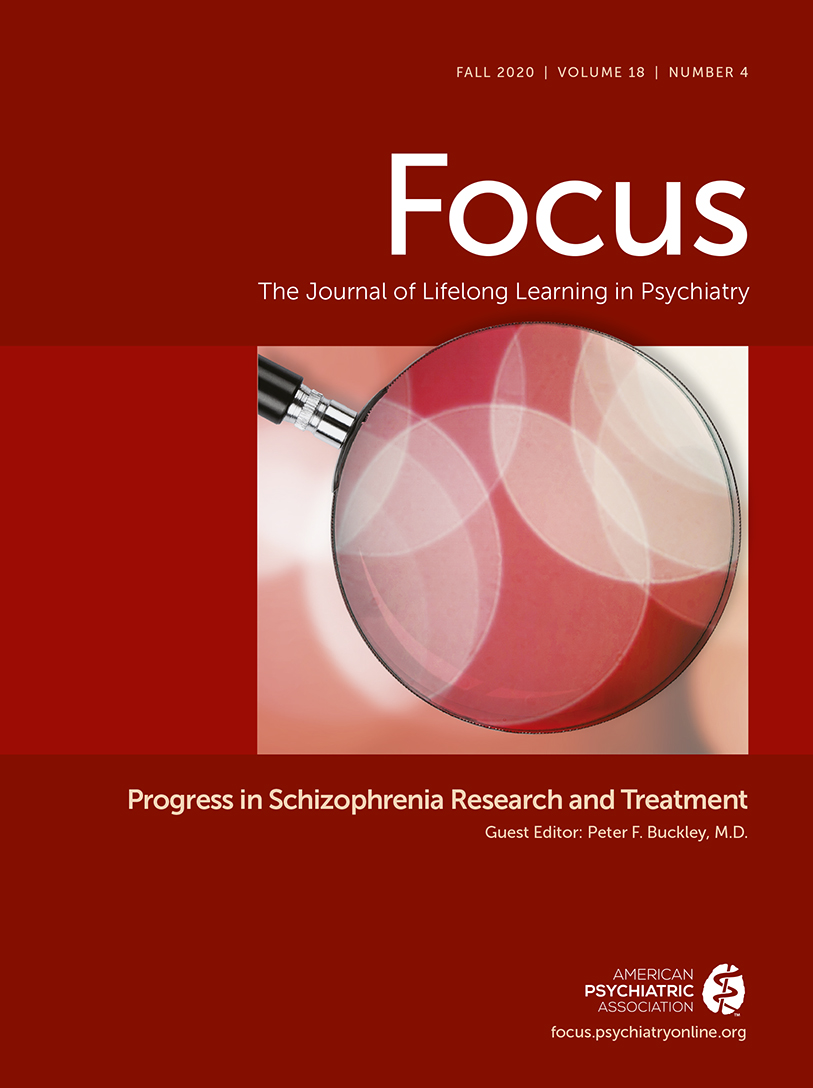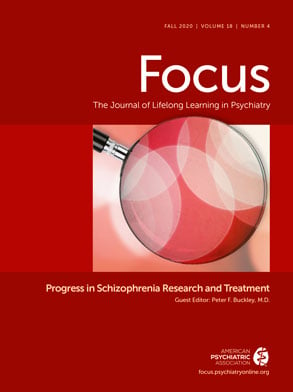Well over 3 decades have passed since Kane and colleagues (
1) conducted the seminal study of clozapine for patients with treatment-resistant schizophrenia (TRS). The study was seminal because of the pronounced treatment response (30% of patients) over 6 weeks of clozapine therapy compared, under double-blind conditions, with chlorpromazine (4% response). It was also a landmark study because it explicitly defined TRS through historical, cross-sectional, and prospective evaluations. The historical criteria included at least 5 years of poor functioning despite three 6-week treatments with different antipsychotic medications (these were first-generation antipsychotics [FGAs]) at dose equivalents of 1,000 mg of chlorpromazine. The prospective component was a 6-week trial of haloperidol (at doses up to 60 mg/day) in which there was failure of treatment response (defined as a response of less than a 20% decline in symptoms as measured on the Brief Psychotic Rating Scale [BPRS]), failure to reduce the BPRS score to ≤35 or Clinical Global Index (CGI) score to ≤3, or both. On a cross-sectional evaluation, these patients with chronic schizophrenia were acutely ill and had high symptom levels, as defined by a BPRS overall score ≥45 and an item score of ≥2 in hallucinations, suspiciousness, disorganization, and unusual thought content. Thus, the rigor of this study is compelling. This landmark historical study has remained relevant for over 3 decades—and remains relevant today—regarding the psychopharmacology of schizophrenia for the following reasons.
First, the concept of TRS remains poorly understood, despite the sharpened focus on TRS that came with clozapine’s prominence as a drug (
2–
4). The definition of TRS in the Kane et al. (
1) study remains valid. Second, there are now many new antipsychotic medications (second-generation antipsychotics; SGAs) available that might have, over this time period, reduced “the pool” of TRS patients (
2,
4). The extent to which this has happened is unclear. Third, these SGAs, although helpful for some TRS patients, do not appear to be as effective as (or more effective than) clozapine. This has been repeatedly shown in studies and in real-world pragmatic studies (
2,
3). Fourth, despite evidence of the clinical superiority of clozapine, this treatment option is conspicuously underutilized (
2,
5,
6). The reasons for this are varied, although the registry-based prescribing with mandated blood work as well as its side effect burden are prominent reasons for the underutilization of clozapine (
6). Finally, with a >30-year demonstration of clozapine’s efficiency, a new generation of psychiatrists have come online, and use of clozapine among these psychiatrists remains low. Given these reasons, this review and “taking stock” of TRS is timely. Moreover, there are recent authoritative reports on the definition, assessment, and treatment of TRS that offer a state-of-the-art appraisal. This review will take its lead from these three reports (
7–
9), augmented by other recent clinical trials and neurobiological perspectives on TRS.
Defining TRS: A Reaffirmation and Extension
Regarding the definitions of TRS, an international leadership in schizophrenia work group called Treatment Response and Resistance in Psychosis (TRRIP) conducted a comprehensive review of all historical definitions and clinical trial definitions of TRS (
7). They found that over half of the clinical trials had inadequate definitions of TRS. They also pointed out that almost all studies reviewed had an inadequate determination of medication compliance. The work group came up with, by consensus, a detailed and well-circumscribed definition and criteria of TRS (see
Box 1). Their criteria cover current symptoms, adequacy of treatment, specific symptom domains, and time course. For each of these four domains, they delineated minimum requirements as well as optimum requirements (more stringent symptom assessments and definitive determination that the patient is compliant with medications). Additionally, the TRRIP work group recognized, unlike in previous definitions of TRS, the existence of “ultra-treatment resistance,” referring to those patients who meet the TRRIP criteria for TRS and do not respond to clozapine therapy. This subgroup is recognized clinically, although it is not given much consideration in the scientific literature. The TRRIP work group also sought to understand “what’s next” in the patient group of clozapine nonresponders (
10). They offered a number of recommendations that were based on first confirming that the dose of clozapine was achieving an adequate serum level, determined to be ≥350 ng/ml. Thereafter, their recommended approaches were specific for each type of recalcitrant symptom. For persistent positive symptoms, they recommended adding another antipsychotic (amisulpride or aripiprazole were the preferred choices) or a trial of electroconvulsive therapy (ECT). For persistent negative symptoms, they recommended adding an antidepressant medication. Persistent suicidality was considered best managed with the addition of an antidepressant medication, a mood-stabilizing drug, or ECT. Adding another antipsychotic medication or a mood-stabilizing medication was recommended for persistent aggression. All that said, the TRRIP work group acknowledged the very limited evidence base for these recommendations regarding clozapine nonresponders. With respect to the definition of TRS, the TRRIP definition builds on the original historical, cross-sectional, and prospective criteria for TRS exemplified in the seminal clozapine study. Moreover, they confirmed these criteria by recommending more rigorous rating scales on the basis of symptom assessment and medication compliance. Interestingly, these TRRIP criteria still endorse the value of two or more previous medication treatment failures, with one of these being a long-acting injectable antipsychotic formulation for satisfying the optimum requirement. All told, these TRRIP criteria have the flexibility and applicability to be useful in the clinical practice; at the same time, the criteria can be “scaled up” in rigor and measurement to support the expected methodological rigor of a comparative clinical trial.
The British Association of Psychopharmacology (BAP) and TRS
The BAP published a 2019 update of its authoritative and influential recommendations on the treatment of schizophrenia (
8). The authors represent a “who’s who” of schizophrenia research in England, and their deliberations on how best to treat schizophrenia emanated from a consensus meeting in 2017. The guidelines are comprehensive and cover all phases of the illness with a rigor that is impressive. The BAP guidelines also cover the treatment of comorbid conditions in schizophrenia. The recommendations for TRS are salutary. Clozapine is endorsed as the primary treatment of choice, with recommendations that medication compliance and comorbid substance abuse be classified as potentially contributory to TRS. They recommended a 6-month trial of clozapine monotherapy, with monitoring of clozapine blood level when the treatment response is suboptimal, substantial adverse effects occur, or both. The group was more circumspect when recommending what drug combination might best augment clozapine therapy when there is insufficient response. They recommended selecting an antipsychotic medication with a receptor profile comparable with that of clozapine (a wide choice, given the polymorphic receptor profile of clozapine) and a drug that is less likely to aggravate the side effects that are already associated with clozapine. These are judicious and offer logical guidance to clinicians.
The group was also less presumptive in endorsing the use of high doses of antipsychotic medications as an alternative treatment option to clozapine for TRS. Similarly, the group did not endorse antipsychotic combinations for TRS. The group recommended that, if clinicians need to resort to these strategies, they should do so cautiously. They recommended that such augmentations have a time-limited appraisal of both response and risk of side effects. Although the BAP guidelines also reviewed the efficiency of valproate and other adjunctive mood-stabilizing drugs for TRS, these options are not endorsed. They are cautiously cited as “last-resort” options. These guidelines are succinct, well written, built on previous BAP guidelines, and authoritative—all in all, well worth the read.
TRS: So What Else Is on the Horizon?
The search for personalized treatment beyond clozapine—especially when clozapine therapy is suboptimal—continues, as do efforts to optimize and inculcate more use of therapeutic drug monitoring for clozapine (
13). The studies cited in the following text are recent, are of variable methodological rigor, and reflect this continued search for treatment beyond clozapine for TRS (
10). Additionally, although these guidelines are authoritative, there are also important studies that counter some recommendations. For example, an influential European study of the early use of clozapine in first-episode schizophrenia decries the recommendation in TRRIP, BAP, and APA guidelines that two trials of antipsychotics are necessary before proceeding to clozapine (
14).
Indeed, the field continues to evolve in its evidence, and guidelines are refined and updated or have occurred with both the BAP and APA guidelines. To that end, readers might also be interested in the recently published “S3 Guideline for Schizophrenia” (
15) from Germany. As new treatments come online, they are tried, on the basis of a predetermined rationale, in patients with schizophrenia. For example, in a group of 10 patients with refractory schizophrenia (six of the 10 patients had previously been responsive to clozapine therapy), Nasrallah and colleagues (
16) demonstrated an impressive response in all patients to pimavanserin. This is a small yet provocative study, particularly of interest because pimavanserin is a novel and selective drug that is an inverse agonist at the serotonin 2-A receptor. In a more substantial, double-blind, multicenter British study, augmentation of clozapine therapy with amisulpride (a highly selective dopamine D2 receptor antagonist) was compared with clozapine monotherapy over 12 weeks (
17). Among 68 patients with TRS, amisulpride was found to be superior to clozapine monotherapy for both symptom improvement overall and for negative symptoms. Amisulpride is not available in the United States, although this drug and another similar agent, sulpride, are widely used in Europe.
Both the APA and BAP guidelines did not endorse ECT as primary treatment for TRS. Not surprisingly, this is an area where there are not a lot of large studies; many studies are of small numbers of patients and have been conducted with weak methodology. In contrast, a follow-up to a very important and rigorous 12-week study of ECT augmentation found a significant benefit of intermittent ECT, when given over 4 months, and showed sustained progress in positive symptoms (
18). Moreover, ECT was well tolerated beyond the initial treatment. Repetitive TMS (rTMS) was not endorsed in either the APA or the BAP guidelines. However, a more recent study of rTMS in 26 patients over 3 weeks of treatment showed a benefit (
19). In contrast and in alignment with the guidelines to date, Siskind and colleagues (
20) found a benefit of rTMS in another recent meta-analysis of rTMS for TRS. In another more futuristic approach, Sun and colleagues (
21) describe the novel application of stem cell therapy in harvesting and successful cultivation of pluripotent stem cells from a patient with TRS: novel yet certainly not clinically relevant for schizophrenia, although it is worth noting that such approaches are being used in more substantial clinical trials in cardiovascular medicine. The coalescence of neurobiology of TRS with a course or trajectory of TRS and how that could inform more selective treatment approaches is a much-desired state (
22).
Seeman also speculates on the role of another innovative area—the microbiome—in TRS (
23). Again, interesting, but not yet ready for prime time! This review ends with a curious yet fascinating observation by Meltzer and colleagues (
24) of a single patient with multiple years of well-documented TRS who later responded to risperidone. The longitudinal observation suggested that something biologically may have changed over time to “convert” the heretofore TRS state to a later, more treatment-responsive state. This is a provocative observation and suggests that we have much to learn from carefully chronicling the responsivity of our patient’s illness to each successive drug.

